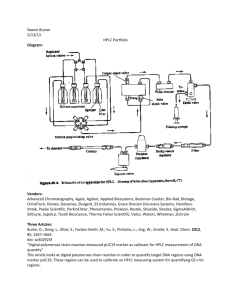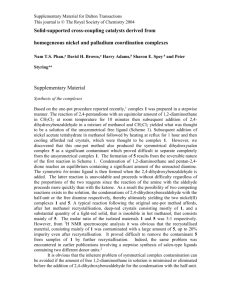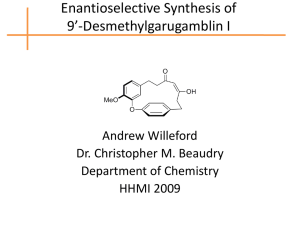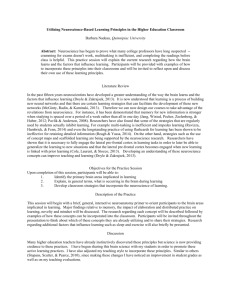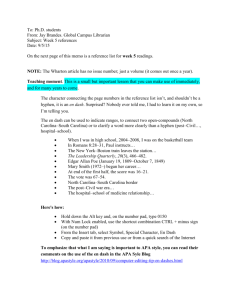NatProt(Hii)final - Spiral
advertisement
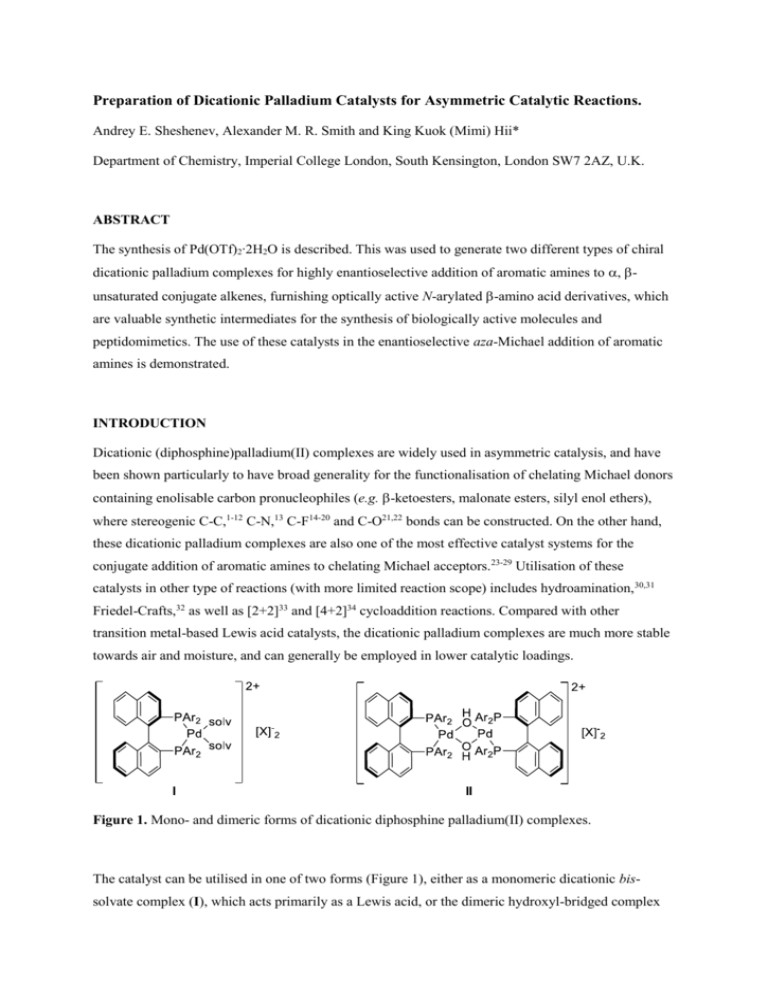
Preparation of Dicationic Palladium Catalysts for Asymmetric Catalytic Reactions.
Andrey E. Sheshenev, Alexander M. R. Smith and King Kuok (Mimi) Hii*
Department of Chemistry, Imperial College London, South Kensington, London SW7 2AZ, U.K.
ABSTRACT
The synthesis of Pd(OTf)2∙2H2O is described. This was used to generate two different types of chiral
dicationic palladium complexes for highly enantioselective addition of aromatic amines to unsaturated conjugate alkenes, furnishing optically active N-arylated -amino acid derivatives, which
are valuable synthetic intermediates for the synthesis of biologically active molecules and
peptidomimetics. The use of these catalysts in the enantioselective aza-Michael addition of aromatic
amines is demonstrated.
INTRODUCTION
Dicationic (diphosphine)palladium(II) complexes are widely used in asymmetric catalysis, and have
been shown particularly to have broad generality for the functionalisation of chelating Michael donors
containing enolisable carbon pronucleophiles (e.g. -ketoesters, malonate esters, silyl enol ethers),
where stereogenic C-C,1-12 C-N,13 C-F14-20 and C-O21,22 bonds can be constructed. On the other hand,
these dicationic palladium complexes are also one of the most effective catalyst systems for the
conjugate addition of aromatic amines to chelating Michael acceptors.23-29 Utilisation of these
catalysts in other type of reactions (with more limited reaction scope) includes hydroamination,30,31
Friedel-Crafts,32 as well as [2+2]33 and [4+2]34 cycloaddition reactions. Compared with other
transition metal-based Lewis acid catalysts, the dicationic palladium complexes are much more stable
towards air and moisture, and can generally be employed in lower catalytic loadings.
Figure 1. Mono- and dimeric forms of dicationic diphosphine palladium(II) complexes.
The catalyst can be utilised in one of two forms (Figure 1), either as a monomeric dicationic bissolvate complex (I), which acts primarily as a Lewis acid, or the dimeric hydroxyl-bridged complex
(II), which has dual Lewis acid-Bronsted base properties. The bis(aqua) complex of the
bis(trifluoromethanesulfonate) salt (solv = H2O, X = CF3SO3) is, by far, the most typical example,
although the nature of the coordinated solvate (solv = CH3CN, or a mixture of H2O and CH3CN) and
counteranion (X = BF4,11 SbF633) can be varied, and can be interchanged.34 The coordinated water
molecule can be easily deprotonated to form the dimeric complex II. Complexes of other congeners
of BINAP, such as tol-BINAP, SEGPhos, etc., are also reported, and are known to be more effective
for certain catalytic reactions.8
A common route to dicationic palladium(II) complexes uses silver salts to abstract halides from the
corresponding [(diphosphine)PdCl2] complex in wet acetone9 or acetonitrile,30 but the method has
drawbacks, namely, the preparation requires the addition of at least two equivalents (often in excess)
of the silver salt to the corresponding [(diphosphine)PdX2] complex (where X = Cl or Br). As a result,
careful and/or repeated recrystallisation of the resultant complex is required to remove all traces of
silver salt, which may also be catalytically active, inducing a competitive formation of racemic
products, compromising the enantioselectivity of the reaction.
In 1994, the preparation of Pd(OTf)2∙2H2O was described by Murata and Ido,35 by the reaction of
palladium(II) salts with trifluoromenthanesulfonic (triflic) acid, who also showed that they can be
used as effective catalyst precursors for the synthesis of [(diphosphine)Pd(OTf)2] complexes.
However, only achiral phosphine ligands were used, and consequently, asymmetric catalysis was not
demonstrated. We have subsequently shown that this palladium salt can be used to generate chiral
catalyst from chiral diphosphines, and demonstrated their utility in the asymmetric aza-Michael
reactions, either as a catalyst precursor, to generate the complexes in situ, or isolated complexes.26
Herein, we will describe the preparation of Pd(OTf)2∙2H2O (1) in detail, from commercially available
reagents; we will also describe how it can be used to generate [(R-BINAP)Pd(OH2)2][OTf]2 (2) and
[(R-BINAP)Pd(µ-OH)]2[OTf]2 (3) complexes, and the examples of how they can be employed to
attain highly enantioselective Michael addition of aromatic amines to N-alkenoyl carbamates.
__________________________________________________________________________________
BOX 1 REPRESENTATIVE EXAMPLE OF THE USE OF 2 AND 3 IN AZA-MICHAEL
ADDITION REACTIONS
Figure 2. Enantioselective addition of an aromatic amine to an N-alkenoyl carbamate.
Catalyst 2 can be used in the addition of non-nucleophilic aromatic amines to -unsaturated
Michael acceptors containing 1,3-dicabonyl chelating moieties, such as N-alkenoyl oxazolidinones,23
carbamates24 or imides36 (Protocol A). On the other hand, for the addition of nucleophilic aromatic
amines, the reaction is more effective when the amine is employed as a salt, in combination with
catalyst 3 (Protocol B),25,28,29 to provide a buffered environment, where catalyst deactivation by amine
binding to the Lewis acidic centre can be minimised.
Protocol A
1 Weigh out methyl (2E)-but-2-enoylcarbamate (0.20 g, 1.40 mmol) and catalyst (2) (0.045 g, 0.042
mmol, 3 mol %), place them into a reaction tube equipped with a magnetic stirring bar, and purge the
tube with nitrogen.
2 Add dry THF (3.5 mL) to the tube via syringe under nitrogen. A yellow solution is formed.
3 Add a solution of aniline (0.13 g, 1.40 mmol) in dry THF (3.5 mL) using a syringe pump (addition
speed 0.2 mL/h) under a nitrogen atmosphere (ambient temperature). When the addition is complete,
the reaction mixture is stirred for a further 3 h. The colour of the reaction mixture turns deep-orange
by the end of the reaction.
<CRITICAL STEP> Fast addition of aniline can cause significant yield deterioration due to the
deactivation of the catalyst.
4 Transfer the reaction mixture into a round bottom flask (50 mL) and concentrated to dryness using a
rotary evaporator.
<CRITICAL STEP> Do not heat the water bath over 35 °C, to avoid possible racemisation of the
product.
5 Pack a chromatography column (D 35 mm, L 300 mm) with 25 g of silica using a mixture of
hexane/ethyl acetate (3:2 v/v) as eluant.
6 Dissolve the crude product in the eluant and load it onto the packed column.
7 Add a layer of quartz sand (5 mm) on top of the column to prevent drying.
8 Elute the column under the atmospheric pressure; collect 5 mL fractions.
9 Analyse the contents of the collected fractions by thin-layer chromatography (using hexane:ethyl
acetate 3:2 v/v), Rf of the product is found at 0.30.
10 Combine fractions containing the product and evaporate using the rotary evaporator.
11 Dry the product under high vacuum.
Protocol B
1 Weigh out methyl (2E)-but-2-enoylcarbamate (0.20 g, 1.40 mmol), aniline triflate (PhNH2∙HOTf,
0.51 g, 2.10 mmol) and catalyst 2 (0.038 g, 0.021 mmol, 1.5 mol %). Place them into a reaction tube
equipped with a magnetic stirring bar, and purge it with nitrogen.
2 Add dry THF (2.8 mL) to the reaction tube via a syringe. A yellow solution is formed.
3 Stir the reaction mixture for 18 h at room temperature. The colour of the reaction mixture turns
orange by the end of the reaction.
4 Quench the reaction mixture by the addition of cold saturated aqueous NaHCO3 (5 mL) with ice
bath cooling.
<CRITICAL STEP> Quenching at room temperature result in a decrease in the enantiomeric purity of
the product.
5 Dilute the reaction mixture with ethyl acetate (10 mL), separate the aqueous layer and extracted it
with ethyl acetate (5 mL).
6 Successively wash the combined organic layers with brine (5 mL) and dry over MgSO4.
7 Filter the solution and remove the solvent using a rotary evaporator.
<CRITICAL STEP> Do not heat the bath over 35 °C to avoid possible racemisation of the product.
8 Purify the residual orange solid by column chromatography on silica gel as described above (steps
5-11).
<CRITICAL STEP> As 1.5 equiv. of aniline triflate is used, unreacted aniline can be recovered in
approx. 80% yield.
(3-Phenylaminobutyryl)carbamic acid methyl ester prepared by Protocol A: yield 76%, 93% ee;
prepared by Protocol B: yield 94%, 97% ee. The physical properties of the aza-Michael adduct are
dependent upon its optical purity. Racemic samples are found to have higher melting points than
optically active samples.37 In this case, the racemic and 93% ee samples appeared as solids (A and B,
figure 4), while the sample containing 97% ee is a colourless viscous oil (C, Figure 4). The products
may be hydrolysed to furnish the corresponding N-aryl--amino acids or amides.24
Colourless gum-like solid, mp 89.5–91 °C, [α]D = –3.3 (c 3.62, CHCl3, 93% ee) or colourless viscous
oil, [α]D –4.9 (c 3.69, CHCl3, 97% ee). Chiral HPLC (Chiralpak AD-H column, 1.0 mL/min,
hexane:IPA 95:5 v/v, 254 nm) tR (major) = 25.0 min, tR (minor) = 29.8 min (Figure 3). 1H NMR (400
MHz, CDCl3) δ 7.86 (br s, 1H), 7.21–7.14 (m, 2H), 6.72 (m, 1H), 6.64 (m, 2H), 4.03 (m, 1H), 3.76 (s,
3H), 3.76 (s, 1H), 3.05 (dd, 1H, J = 15.9, 6.0 Hz), 2.89 (dd, 1H, J = 15.9, 6.0 Hz), 1.30 (d, 3H, J = 6.3
Hz). 13C-{1H} NMR (100 MHz, CDCl3) δ 172.6, 152.2, 146.7, 129.3, 118.0, 113.9, 53.0, 46.0, 42.2,
20.8.
Figure 3. Chiral HPLC chromatograms of (3-phenylaminobutyryl)carbamic acid methyl ester: (a)
racemic sample; (b) prepared by protocol A; (c) prepared by protocol B.
Figure 4. Visual appearances of the aza-Michael adduct: A = racemic sample; B = 93% ee; C = 97%
ee.
__________________________________________________________________________________
EXPERIMENTAL DESIGN
Figure 5. Reaction Scheme.
Due to the highly corrosive nature of nitric acid and trifluoromethanesulfonic acid, added precaution
is necessary to avoid direct contact with these reagents during the preparation of Pd(OTf) 2∙2H2O. The
triflate salt is isolated as a hygroscopic, light purple/lilac powder, which will degrade within minutes
into a dark brown liquid if left exposed to moist air. Pd(OTf)2∙2H2O has been prepared successfully
several times in our laboratory on 1-10 g scale. When not used immediately, it can be kept in a sealed
tube over P2O5 in a desiccator for up to a year without any visible degradation.
Use of acetonitrile as a coordinating solvent helps to stabilise the product and avoid the formation of
the 1:2 adduct, [Pd(R-BINAP)2][OTf]2, which is observed as a side-product when the reaction is
performed in CH2Cl2.26 During the preparation of the diphosphine complexes, exposure of
Pd(OTf)2∙2H2O to acetonitrile in the absence of ligands should be kept to a minimum to avoid
polymerisation of the solvent. Once prepared, the diphosphine palladium complexes can be stored at
room temperature in a sealed vial, although exposure to light should be minimised. Samples prepared
>5 years ago in our laboratory has retained their original effectiveness.
The procedure has been repeated numerous times by several researchers of varying abilities
(undergraduate, postgraduate and postdoctoral researchers) in over 7 years in our laboratory, during
which the chemical precursors have been procured from different sources. This did not cause
noticeable differences in the results.
MATERIALS
CAUTION: All synthetic operations must be carried out in a fume cupboard. Personal protective
clothing (nitrile gloves, laboratory coat and safety glasses) must be donned at all times.
• Palladium(II) nitrate hydrate (CAS Number 11102-05-3) <CAUTION> Oxidizer, irritant
• Trifluoromethanesulfonic acid (CAS Number 1493-13-6) <CAUTION> Highly corrosive, toxic
• (R)-(+)-(1,1′-Binaphthalene-2,2′-diyl)bis(diphenylphosphine) (CAS Number 76189-55-4)
• Potassium carbonate <CAUTION> Toxic, irritant
• Sodium hydroxide <CAUTION> Toxic, irritant
• Magnesium sulfate (anhydrous)
• Acetonitrile extra dry (CAS Number 75-05-8) <CAUTION> Flammable, toxic, irritant
• Diethyl ether (anhydrous) <CAUTION> Highly flammable, toxic
• Dichloromethane (anhydrous) <CAUTION> Suspected carcinogenity
• Celite® 512 Medium (CAS Number 91053-39-3) <CAUTION> Irritant
EQUIPMENT
•
5-digit analytical balance
•
Thermally controlled magnetic stirring plate
•
Dreschel bottle (250 mL)
•
Schlenk tubes (50 mL, 100 mL)
•
Tubing adapter with side arm (cone size19/26, socket size 19/26)
•
Rubber septa (joint: ST/NS 14/20, 19/22, 24/40)
•
PVC tubing (8 mm bore, 10 mm O.D.)
•
Teflon-coated stirring bars
•
Disposable syringes (5 mL, 10 mL, 20 mL)
•
Stainless steel needle (170 mm in length, size 21 gauge)
•
Pasteur pipettes
•
Pyrex centrifuge tubes (20 mL)
•
Erlenmeyer flasks (100 mL, 500 mL)
•
Centrifuge machine
•
Glass vacuum oven for sample drying
•
High-vacuum pump
•
Disposable needles (120 mm, 50 mm)
•
Funnels (diameter 55 mm, 80 mm)
•
Pump (max pressure 100 mmHg)
•
Heavy wall flat bottomed filter flasks (500 mL)
•
Filtration funnel (diameter 4.5 mm, porosity 2)
•
Melting point apparatus
•
Polarimeter
REAGENT SETUP
• Anhydrous solvents (dichloromethane and diethyl ether) were obtained using a solvent purification
apparatus, by passing them through columns of activated molecular sieves under N2.
• Preparation of 0.07 M aq. NaOH: the title solution was prepared by dissolving NaOH pellets (0.28 g,
7.00 mmol) in distilled water (100 mL).
EQUIPMENT SETUP
Figure 6. Equipment setup for the preparation of Pd(OTf)2∙2H2O (steps 1-4).
•
Preparation of palladium triflate (Figure 6): the Schlenk tube and stirring bar were oven-dried
at 100 °C overnight. The Schlenk tube is attached to a N2/vacuum double manifold via a side arm
adapter, placed on top of the Schlenk tube (labeled A). The top of the adapter was then sealed with a
rubber septum (closing the tap on the side of the Schlenk tube then gives a sealed vessel which can be
purged). The hose connector on the side of the Schlenk tube (labeled B) was connected via plastic
tubing to a Dreschel bottle containing a sat. aq. K2CO3 solution (labeled C). This acts as an acid
scrubber for the waste stream.
•
The glass vacuum oven for drying was set up at 120 °C.
•
The centrifuge was set up at 1500 g.
Procedure
Steps 1-7: Synthesis of palladium(II) bis(trifluoromethansulfonate) dihydrate, Pd(OTf)2.2H2O, 1
1 Weigh out Pd(NO3)2.nH2O (1.00 g, 4.34 mmol, anhydrous basis) and place it in a Schlenk tube
equipped with a stirring bar. Seal with a rubber septum. Close the tap (B) on the side arm of the
Schlenk tube.
2 Attach the flask to a Schlenk line via the tubing adapter (A), and evacuate the flask by the
application of vacuum for 10 min with magnetic stirring, then fill it with nitrogen gas under a slightly
positive pressure.
3 The tap on the Schlenk tube’s side-arm (B) is then released, such that a steady stream of nitrogen
flows from the flask into the Dreschel bottle containing a solution of sat. aq. K2CO3 (acid scrubber).
Flow rate ca. 3 bubbles/sec.
4 With the magnetic stir bar set to rotate at 400 rpm, add triflic acid (7.30 mL, 83.00 mmol) dropwise
to the flask using a disposable plastic syringe. Fuming (nitric acid vapour) should be immediate
visible (Figure 7) Maintain a rate of addition such as to allow for a slow but steady quench of the acid
vapour by the acid scrubber. After complete addition, allow the resultant mixture to stir at room
temperature for a further 2 h.
<CAUTION> Maintain a steady flow of nitrogen through the apparatus throughout the procedure to
purge the nitric acid fumes, and to ensure that K2CO3 solution cannot be drawn back into the reaction
vessel, risking violent reaction with triflic acid.
5 Using a wide pipette, transfer the lilac slurry in roughly equal quantities to two centrifuge tubes
(Figure 7), seal them with rubber septa and centrifuge at 1500 g for 5 min.
6 Remove the supernatant using a pipette, and place the tubes in a small vacuum oven to dry at 120
°C and 0.03 mmHg for 18 h.
<CRITICAL STEP> Whist slurried in triflic acid, palladium (II) triflate is stable enough to be handled
briefly in air.
7 Flush the drying piston with dry nitrogen before retrieving the tubes, which are immediately sealed
with a rubber septum.
<PAUSE POINT> Palladium triflate dihydrate is a pale-lilac powder. It is highly moisture sensitive
and must be handled avoiding contact with air and stored in a desiccator over P2O5. Other less
powerful desiccants are less effective.
Figure 7. (a) Step 4: the addition of triflic acid; (b) Step 5: transfer of the suspension containing the
lilac product.
Steps 8-14: Synthesis of [(R-BINAP)Pd(OH2)2][OTf]2, 2
8 Equip a Schlenk tube with a stirring bar and a rubber septum, then purge with nitrogen via the sidearm. Close the tap and remove the nitrogen line, record the tare weight of the flask.
9 Under an inverted funnel attached to a nitrogen line, add Pd(OTf)2∙2H2O (1) (2.44 g, 5.54 mmol) to
the flask.
<CRITICAL STEP> In order to reduce exposure to air, the palladium salt should be added in a single
portion. Seal the flask immediately and weigh it again to ascertain the exact quantity.
10 Re-attach the nitrogen line to the side-arm and add dry acetonitrile (50 mL). The formation of an
orange solution is observed. The solution will look brown/black in the presence of colloidal
palladium.
11 Remove the rubber septum and add (R)-BINAP (3.45 g, 5.54 mmol) to the solution as a single
portion (Figure 8). Reseal the tube and stir the reaction mixture at room temperature for 30 min. If a
clear, yellow solution is obtained, step 12 can be skipped.
12 Using a Buchner funnel, filter the solution through a short plug of Celite (~2 cm) and rinse with 10
mL of acetonitrile (Figure 8).
13 Dilute the filtrate (yellow solution) with diethyl ether (300 mL). Leave the resulting solution for 30
min at room temperature to let the product precipitate (Figure 9). Collect the precipitated product
using a frit, rubber ring and filtration funnel.
14 Allow the solid to dry under vacuum.
<PAUSE POINT> The desired product is a stable yellow crystalline solid, which can be stored
indefinitely at room temperature in a closed vial, purged with nitrogen.
Figure 8. (a) Step 11: Addition of (R)-BINAP to the solution of Pd(OTf)2.2H2O. (b) Step 12:
Filtration of reaction mixture through Celite.
Figure 9. Step 13: Precipitation of complex 2.
Steps 15-19: Synthesis of [(R-BINAP)Pd(µ-OH)]2[OTf]2, 3
15 Weigh [(R-BINAP)Pd(OH2)2][OTf]2 (1.30 g, 1.22 mmol) into a 100 mL Erlenmeyer flask
containing a magnetic stirrer. Dissolve it in dichloromethane (20 mL) to form a yellow solution.
16 Using a 20 mL syringe, add aq. NaOH (0.07 M, 17.5 mL) in one portion (Figure 10, left). To stop
the solvent from evaporating, seal the top of the reaction flask with an inverted septum, with an
escape needle (Figure 10, middle). Stir the reaction mixture vigorously for 2 h, whereupon the
solution turns a deep burgundy colour (Figure 10, right).
17 Separate the biphasic mixture in a separatory funnel; wash the organic layer with water (3×15 mL),
dry it over anhydrous MgSO4.
18 Separate the solution from the desiccant by filtration, and concentrate the filtrate using a rotary
evaporator.
19 Recrystallize the crude product from dichloromethane/diethyl ether mixture (1.5 mL/5.0 mL),
collect the product by filtration
20 Dry the product under high vacuum.
<PAUSE POINT> The desired product is a stable red-orange powder and can be stored at room
temperature in a closed vial purged with nitrogen.
Figure 10. Step 16: Addition of aq. NaOH and colour change observed during the reaction.
Figure 11. Appearance of: (a) Palladium salt 1; and (b) complexes 2 (left) and 3 (right).
TIMING
• Synthesis of (1): Steps 1-3, 15 min; Step 4, 2 h 10 min; Step 5, 10 min; Steps 6-7, 18 h 15 min. Total
time: 20 h 50 min.
• Synthesis of (2): Step 8, 10 min; Step 9, 5 min; Step 10, 10 min; Steps 11, 35 min; Step 12, 15 min;
Step 13, 1 h; Step 14, 3 h. Total time: 5 h 15 min.
• Synthesis of (3): Step 15, 10 min; Step 16, 2 h 5 min; Steps 17-18, 1 h; Step 19, 30 min; Step 20, 3
h. Total time: 6 h 45 min.
ANTICIPATED RESULTS
In general, yields are usually very good for these reactions:
Palladium salt 1: 90–94 %; monomeric complex 2: 91–97%; dimeric complex 3: 90–97%.
TROUBLESHOOTING
Step
Problem
Solution
7
Pd(OTf)2∙2H2O (1) appears brown
The colour change is due to exposure to
moist air. In some cases, it may still be
used for the preparation of 2, albeit in a
lower yield.
14
Poor recovery of complex 2
The mother liquor (filtrate) obtained in
step 13 can be evaporated using the
rotavap, and further crops of crystals
obtained by recyrstallisation from
acetonitrile/ether or
dichloromethane/ether.
14
Impurity present in diphosphine
Purified by recrystallisation (above), or
complex 2
start the synthesis again with a fresh
sample of 1.
16
Colour change not observed
The colour change may not be observed
if more dilute solutions of NaOH is used
(< 0.007 M). In this case, the reaction
progress can be monitored by diluting
aliquots of the organic layer with
CDCl3and analysed by 31P NMR
spectroscopy.
ANALYTICAL DATA
Palladium triflate dihydrate (1): yield 94 %, pale-lilac powder, mp > 300 °C.
[(R)-(+)-2,2′-bis(diphenylphosphino)-1,1′-binaphthyl]-diaquo-palladium(II)
bis(trifluoromethanesulfonate) (2): yield 97 %, yellow crystals, mp 182.0–184.0 °C, [α]20D = +367.2 (c 1.22,
CH2Cl2).
1
H NMR (400 MHz, CDCl3) δ 7.86–7.84 (m, 6H), 7.70–7.63 (m, 12H), 7.56–7.50 (4H, m), 7.22 (t, 2H, J = 6.6
Hz), 7.06–7.02 (m, 3H), 6.90 (br s, 3H), 6.73 (d, 2H, J = 8.6 Hz), 4.00–3.75 (br s, 4H), 1.91 (s, 3H).
13
C-{1H} NMR (100 MHz, CDCl3) δ 139.6, 135.0, 134.9, 134.8, 134.5, 133.0, 132.9, 132.0, 130.4, 130.3,
129.4, 129.3, 129.1, 128.7, 128.5, 127.7, 127.6, 127.0, 124.5, 123.9, 123.0, 122.4, 122.0, 121.0, 118.9, 118.8,
118.3, 2.3
31
P -{1H} NMR (162 MHz, CDCl3) δ +33.0 (s)
[bis{((R)-(+)-2,2′-bis(diphenylphosphino)-1,1′-binaphthyl)palladium(II)}bis(μ−hydroxo)]
bis(trifluoromethanesulfonate) (3): yield 97 %, red-orange powder, mp 223.0–224.0 °C, [α]20D =+652.2 (c
1.15, CH2Cl2).
1
H NMR (400 MHz, CDCl3) δ 7.73–7.70 (m, 6H), 7.66–7.64 (m, 6H), 7.55–7.47 (m, 16H), 7.44–7.40 (m, 6H),
7.23–7.21 (t, 10H, J = 7.0 Hz), 7.11–7.03 (m, 16H), 6.59 (d, 4H, J = 8.6 Hz), -2.85 (s, 2H).
13
C-{1H} NMR (100 MHz, CDCl3) δ 138.6, 138.6, 138.5, 134.7, 134.4, 132.9, 131.7, 131.6, 130.1, 128.9,
128.9, 128.8, 128.5, 128.2, 127.0, 126.9, 124.8, 124.1, 123.4, 123.0, 122.8, 120.4, 119.9, 119.8
31
P-{1H} NMR (162 MHz, CDCl3) δ +29.1 (s)
AFFILIATION
Department of Chemistry, Imperial College London, U.K.
ACKNOWLEDGMENTS
AES is supported by a Marie Curie Intra European Fellowship, within the 7th European Community
Framework Programme (Project 252247).
CONTRIBUTIONS
AMRS refined the original procedures for catalyst preparation, AES carried out the experimental
procedure and aza-Michael reactions, and KKH assembled the manuscript.
COMPETING FINANCIAL INTERESTS
The authors declare no competing financial interests.
CORRESPONDING AUTHOR
Correspondence to: K. K. (Mimi) Hii, Department of Chemistry, Imperial College London, South
Kensington, London SW7 2AZ, U.K.
REFERENCES
1
Hamashima, Y., Hotta, D. & Sodeoka, M. Direct generation of nucleophilic chiral palladium
enolate from 1,3-dicarbonyl compounds: Catalytic enantioselective Michael reaction with
enones. J. Am. Chem. Soc. 124, 11240-11241 (2002), doi:10.1021/ja027075i.
2
Hamashima, Y., Hotta, D., Umebayashi, N., Tsuchiya, Y., Suzuki, T. & Sodeoka, M.
Catalytic enantioselective Michael reaction of 1,3-dicarbonyl compounds via formation of
chiral palladium enolate. Adv. Synth. Catal. 347, 1576-1586 (2005),
doi:10.1002/adsc.200505199.
3
Hamashima, Y., Sasamoto, N., Hotta, D., Somei, H., Umebayashi, N. & Sodeoka, M.
Catalytic asymmetric addition of beta-ketoesters to various Imines by using chiral palladium
complexes. Angew. Chem. Int. Ed. 44, 1525-1529 (2005), doi:10.1002/anie.200462202.
4
Sasamoto, N., Dubs, C., Hamashima, Y. & Sodeoka, M. Pd(II)-catalyzed asymmetric addition
of malonates to dihydroisoquinolines. J. Am. Chem. Soc. 128, 14010-14011 (2006),
doi:10.1021/ja065646r.
5
Fukuchi, I., Hamashima, Y. & Sodeoka, M. Catalytic asymmetric aldol reactions of
enolizable carbon pronucleophiles with formaldehyde and ethyl glyoxylate. Adv. Synth. Catal.
349, 509-512 (2007), doi:10.1002/adsc.200600568.
6
Umebayashi, N., Hamashima, Y., Hashizume, D. & Sodeoka, M. Catalytic enantioselective
aldol-type reaction of beta-ketosters with acetals. Angew. Chem. Int. Ed. 47, 4196-4199
(2008), doi:10.1002/anie.200705344.
7
Hamashima, Y., Sasamoto, N., Umebayashi, N. & Sodeoka, M. Pd-II-catalyzed asymmetric
addition reactions of 1,3-dicarbonyl compounds: Mannich-type reactions with N-Boc Imines
and three-component aminomethylation. Chemistry--Asian J. 3, 1443-1455 (2008),
doi:10.1002/asia.200800120.
8
Sodeoka, M. & Hamashima, Y. Chiral Pd aqua complex-catalyzed asymmetric C-C bondforming reactions: a Brønsted acid-base cooperative system. Chem. Commun. 5787-5798
(2009), doi:10.1039/b911015a.
9
Sodeoka, M., Tokunoh, R., Miyazaki, F., Hagiwara, E. & Shibasaki, M. Stable diaqua
palladium(II) complexes of BINAP and Tol-BINAP as highly efficient catalysts for
asymmetric aldol reactions. Synlett, 463 (1997).
10
Hagiwara, E., Fujii, A. & Sodeoka, M. Enantioselective addition of enol silyl ethers to imines
catalyzed by palladium complexes: A novel way to optically active acylalanine derivatives. J.
Am. Chem. Soc. 120, 2474-2475 (1998), doi:10.1021/ja973962n.
11
Fujii, A., Hagiwara, E. & Sodeoka, M. Mechanism of palladium complex-catalyzed
enantioselective Mannich-type reaction: Characterization of a novel binuclear palladium
enolate complex. J. Am. Chem. Soc.121, 5450-5458 (1999), doi:10.1021/ja9902827.
12
Fujii, A., Hagiwara, E. & Sodeoka, M. Asymmetric Mannich-type reaction catalyzed by
palladium complexes. J. Synth. Org. Chem. Jpn 58, 728-735 (2000).
13
Kang, Y. K. & Kim, D. Y. Catalytic enantioselective electrophilic α-amination of β-ketoesters
catalyzed by chiral palladium complexes. Tetrahedron Lett. 47, 4565-4568 (2006),
doi:10.1016/j.tetlet.2006.05.003.
14
Hamashima, Y., Yagi, K., Takano, H., Tamas, L. & Sodeoka, M. An efficient
enantioselective fluorination of various beta-ketoesters catalyzed chiral palladium complexes.
J. Am. Chem. Soc. 124, 14530-14531 (2002), doi:10.1021/ja028464f.
15
Hamashima, Y., Suzuki, T., Takano, H., Shimura, Y. & Sodeoka, M. Catalytic
enantioselective fluorination of oxindoles. J. Am. Chem. Soc. 127, 10164-10165 (2005),
doi:10.1021/ja0513077.
16
Hamashima, Y., Suzuki, T., Shimura, Y., Shimizu, T., Umebayashi, N., Tamura, T.,
Sasamoto, N. & Sodeoka, M. An efficient catalytic enantioselective fluorination of betaketophosphonates using chiral palladium complexes. Tetrahedron Lett. 46, 1447-1450 (2005),
doi:10.1016/j.tetlet.2005.01.018.
17
Hamashima, Y., Suzuki, T., Takano, H., Shimura, Y., Tsuchiya, Y., Moriya, K.-i., Goto, T. &
Sodeoka, M. Highly enantioselective fluorination reactions of beta-ketoesters and betaketophosphonates catalyzed by chiral palladium complexes. Tetrahedron 62, 7168-7179
(2006), doi:10.1016/j.tet.2005.12.070.
18
Hamashima, Y. & Sodeoka, M. Enantioselective fluorination reactions catalyzed by chiral
palladium complexes. Synlett, 1467-1478 (2006), doi:10.1055/s-2006-941578.
19
Moriya, K.-i., Harnashima, Y. & Sodeoka, M. Pd(II)-catalyzed asymmetric fluorination of
alpha-aryl-alpha-cyanophosphonates with the aid of 2,6-lutidine. Synlett, 1139-1142 (2007),
doi:10.1055/s-2007-977437.
20
Suzuki, T., Goto, T., Hamashima, Y. & Sodeoka, M. Enantioselective fluorination of tertbutoxycarbonyl lactones and lactams catalyzed by chiral Pd(II)-bisphosphine complexes. J.
Org. Chem. 72, 246-250 (2007), doi:10.1021/jo062048m.
21
Smith, A. M. R., Billen, D. & Hii, K. K. Palladium-catalysed enantioselective alphahydroxylation of beta-ketoesters. Chem. Commun. 3925-3927 (2009), doi:10.1039/b907151b.
22
Smith, A. M. R., Rzepa, H. S., White, A. J. P., Billen, D. & Hii, K. K. Delineating Origins of
Stereocontrol in Asymmetric Pd-Catalyzed alpha-Hydroxylation of 1,3-Ketoesters. J. Org.
Chem. 75, 3085-3096 (2010), doi:10.1021/jo1002906.
23
Li, K. L. & Hii, K. K. Dicationic [(BINAP)Pd(solvent)2][TfO]2: enantioselective
hydroamination catalyst for alkenoyl-N-oxazolidinones. Chem. Commun., 1132-1133 (2003),
doi:10.1039/b302246c.
24
Li, K. L., Cheng, X. H. & Hii, K. K. Asymmetric synthesis of beta-amino acid and amide
derivatives by catalytic conjugate addition of aromatic amines to N-alkenoylcarbamates. Eur.
J. Org. Chem., 959-964 (2004), doi:10.1002/ejoc.200300740.
25
Hamashima, Y., Somei, H., Shimura, Y., Tamura, T. & Sodeoka, M. Amine-salt-controlled,
catalytic asymmetric conjugate addition of various amines and asymmetric protonation. Org.
Lett. 6, 1861-1864 (2004), doi:10.1021/ol0493711.
26
Phua, P. H., White, A. J. P., de Vries, J. G. & Hii, K. K. Enabling ligand screening for
palladium-catalysed enantioselective aza-Michael addition reactions. Adv. Synth. Catal. 348,
587-592 (2006), doi:10.1002/adsc.200505404.
27
Phua, P. H., Mathew, S. P., White, A. J. P., de Vries, J. G., Blackmond, D. G. & Hii, K. K.
Elucidating the mechanism of the asymmetric aza-Michael reaction. Chemistry—Eur. J. 13,
4602-4613 (2007), doi:10.1002/chem.200601706.
28
Hamashima, Y., Tamura, T., Suzuki, S. & Sodeoka, M. Enantioselective protonation in the
aza-Michael reaction using a combination of chiral Pd-mu-hydroxo complex with an amine
salt. Synlett 1631-1634 (2009), doi:10.1055/s-0029-1217347.
29
Hamashima, Y., Suzuki, S., Tamura, T., Somei, H. & Sodeoka, M. Scope and mechanism of
tandem aza-Michael reaction/enantioselective protonation using a Pd-mu-hydroxo complex
under mild conditions buffered with amine salts. Chemistry--Asian J. 6, 658-668 (2011),
doi:10.1002/asia.201000740.
30
Li, K. L., Horton, P. N., Hursthouse, M. B. & Hii, K. K. Air- and moisture-stable cationic
(diphosphine)palladium(II) complexes as hydroamination catalysts X-ray crystal structures of
two [(diphosphine)Pd(NCMe)(OH2)][OTf]2 complexes. J. Organomet. Chem. 665, 250-257
(2003), doi:10.1016/s0022-328x(02)02138-1.
31
Kawatsura, M. & Hartwig, J. F. Palladium-catalyzed intermolecular hydroamination of
vinylarenes using arylamines. J. Am. Chem. Soc. 122, 9546-9547, doi:10.1021/ja002284t
(2000).
32
Kang, Y. K., Kwon, B. K., Mang, J. Y. & Kim, D. Y. Chiral Pd-catalyzed enantioselective
Friedel-Crafts reaction of indoles with gamma,delta-unsaturated beta-keto phosphonates.
Tetrahedron Letters 52, 3247-3249 (2011), doi:10.1016/j.tetlet.2011.04.084.
33
Aikawa, K., Hioki, Y. t., Shimizu, N. & Mikami, K. Catalytic asymmetric synthesis of stable
oxetenes via Lewis acid-promoted [2 + 2] cycloaddition. J. Am. Chem. Soc. 133, 2009220095 (2011), doi:10.1021/ja2085299.
34
Pignat, K., Vallotto, J., Pinna, F. & Strukul, G. Cationic complexes of palladium(II) and
platinum(II) as Lewis acid catalysts for the Diels−Alder reaction. Organometallics 19, 51605167 (2000), doi:10.1021/om0003943.
35
Murata, S. & Ido, Y. Practical synthesis of palladium bis(trifluoromethanesulfonate) and its
application to the synthesis of palladium complexes. Bull. Chem. Soc. Jpn. 67, 1746-1748
(1994), doi:10.1246/bcsj.67.1746
36
Phua, P. H., de Vries, J. G. & Hii, K. K. Palladium-catalysed enantioselective conjugate
addition of aromatic amines to alpha,beta-unsaturated N-imides. Effect of the chelating
moiety. Adv. Synth. Catal. 347, 1775-1780 (2005), doi:10.1002/adsc.200505126.
37
Guino, M., Phua, P. H., Caille, J. C. & Hii, K. K. A concise asymmetric synthesis of
torcetrapib. J. Org. Chem. 72, 6290-6293 (2007), doi:10.1021/jo071031g.
